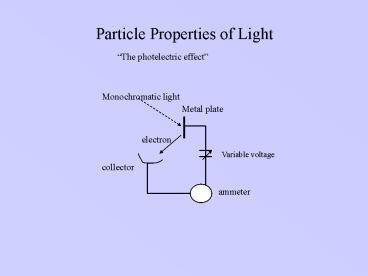Particle Properties of Light - PowerPoint PPT Presentation
1 / 23
Title:
Particle Properties of Light
Description:
Wave-Particle Duality. How can light be both a particle and a wave? ... Wave-Particle Duality. Energy-Matter Interactions. The Bohr Atom ... – PowerPoint PPT presentation
Number of Views:238
Avg rating:3.0/5.0
Title: Particle Properties of Light
1
Particle Properties of Light
The photelectric effect
2
Particle Properties of Light
Photoelectric effect summary
- Photo electrons are detected whenever metal is
illuminated by light of a frequency V, which is
greater than a critical or threshold frequency
irrespective of the intensity of the light - This is in direct conflict with predictions based
on the wave picture of light. If light is a
classical wave the electrons should absorb energy
continuously, and at any intensity it should be
just a matter of time until an electron has
sufficient energy to escape. Thus there should be
no threshold frequency.
3
Particle Properties of Light
Einsteins Explanations
Photoelectric effect could be explained if one
assumed that the energy carried by the incoming
light came in discrete amounts. Furthermore, he
suggested that amount of energy in each light
quantum or photon depends only on the frequency
(v) of the light and not on the intensity. The
intensity of a beam of light is determined by the
number of photons present the energy of each
photon is determined by the frequency.
4
Particle Properties of Light
Energy of a photon is
Q h v
Where h is Plancks constant 6.625 x 10 34 Js
- hc/hv
- hc/Q
Note energy is inversely related to wavelength
5
Particle Properties of Light
More evidence for the particle model (A.H
Compton)
Photon incident on a stationary electron is
scattered. The energy and momentum lost by the
photon are taken up by the electron. Billiard
Ball analogy total momentum of the photon and
electron is conserved
6
Wave-Particle Duality
How can light be both a particle and a wave?
We can reconcile these two ideas by viewing the
photon as a small wave bundle with energy hv. The
energy of the bundle is determined by its
frequency. The photon is a wave disturbance
localized in a small region of space, much like a
particle. Many photons at a single frequency
behave similar to a continuous wave when they
refract, disperse, reflect, etc..
7
Wave-Particle Duality
luminous beings are we not this crude matter
8
Energy-Matter Interactions
The Bohr Atom
9
Energy-Matter Interactions(atomic emission)
Discrete emission
- hc/Q
Continuous emission
10
Energy-Matter Interactions
1.Refraction bending of light through mediums
of different density. Been there, done that. 2.
Reflectance is process whereby radiation
bounces off an object 3. Scattering
reflectance in an unpredictable manner 4.
Absorption process by which radiation is
absorbed and converted to other forms of energy.
5. Transmittance process by which radiation
passes through a material.
11
Energy-Matter Interactions
Radiation Budget Equation
?i? ?reflected ?transmitted ?absorbed
Where ?i? total flux incident on surface
Energy is conserved!
12
Energy-Matter Interactions
Radiant flux (?) measured in watts or J/s
r? ?reflected / ?i?
Hemispherical reflectance Hemispherical
transmittance Hemispherical absorptance
? ? ?transmitted / ?i?
? ? ?absorbed / ?i?
r? ? ? ? ? 1
Where ?i? total flux incident on surface
13
Energy-Matter Interactions
Irradiance E? ?i?/ A
Exitance M? ?i?/ A
Radiant Flux Density amount of radiant flux (?
)divided by the area of the surface it is
incident upon (irradiance) or is leaving
(exitance) W/m2
14
Energy-Matter Interactions
Radiance radiant flux per unit solid angle in a
given direction per unit of projected source area
in that direction.
15
Energy-Matter Interactions
Projected Source Area A Acos?
Solid angle (?) A / q2 measured in steradians
(sr)
?
16
Energy-Matter Interactions
Radiance radiant flux per unit solid angle in a
given direction per unit of projected source area
in that direction.
17
Energy-Matter Interactions (reflectance)
18
The Remote Sensing Problem
Where does all the energy come from?
Stefan Boltzmann law
M? ?T4
where ? 5.6697 x 10-8 Wm-2 K-4 T temp in
Kelvin
Wiens displacement law
?max k/T Where k is a constant 2898 ?m K
19
The Remote Sensing Problem
Blackbody radiation curves
20
The Remote Sensing Problem
Absorption
21
The Remote Sensing Problem
22
The Remote Sensing Problem
Scattering
23
The Remote Sensing Problem































